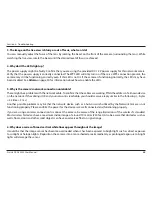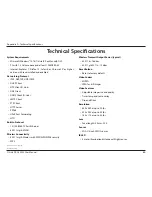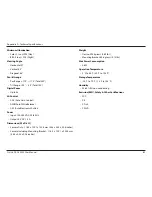
71
D-Link DCS-5000L User Manual
Appendix B - Regulatory Information
• Move products with care; ensure that all casters and/or stabilizers are firmly connected to the system. Avoid sudden stops and uneven
surfaces.
Environment
• Do not use this device near water (e.g. near a bathtub, sink, laundry tub, fish tank, in a wet basement or near a swimming pool).
• Do not use this device in areas with high humidity.
• This device must not be subjected to water or condensation.
• Keep your device away from radiators and heat sources. Also, do not block cooling vents.
Cleaning
• Always unplug the power before cleaning this device.
• Do not use liquid or aerosol cleaners of any kind. Use only compressed air that is recommended for electronic devices.
• Use a dry cloth for cleaning.
Protecting Against Electrostatic Discharge
Static electricity can harm delicate components inside your system. To prevent static damage, discharge static electricity from your body before
you touch any of the electronic components, such as the microprocessor. You can do so by periodically touching an unpainted metal surface on
the chassis.
You can also take the following steps to help prevent damage from electrostatic discharge (ESD):
1. When unpacking a static-sensitive component from its shipping carton, do not remove the component from the antistatic packing
material until you are ready to install the component in your system. Just before unwrapping the antistatic packaging, be sure to discharge
static electricity from your body.
2. When transporting a sensitive component, first place it in an antistatic container or packaging.
3. Handle all sensitive components in a static-safe area. If possible, use antistatic floor pads, workbench pads, and an antistatic grounding
strap.
Environmental
This product may contain a battery. Recycle or dispose of batteries in accordance with the battery manufacturer's instructions and local/national
disposal and recycling regulations. For more information, please refer to the warranty guide.








































